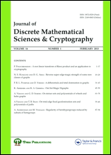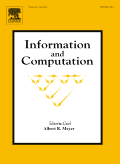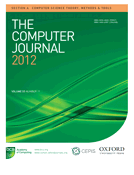
JOURNAL OF DISCRETE MATHEMATICAL SCIENCES & CRYPTOGRAPHY
Scope & Guideline
Pioneering Research in Cryptography and Algebra
Introduction
Aims and Scopes
- Discrete Mathematics:
The journal focuses on various aspects of discrete mathematics, including graph theory, combinatorics, and number theory, emphasizing their applications in cryptographic methods and algorithms. - Cryptography and Information Security:
A core area of the journal is the study of cryptographic techniques, protocols, and their resilience against modern threats, including quantum computing vulnerabilities and lightweight cryptography for resource-constrained devices. - Computer Security and Privacy:
Research on securing digital communications, data integrity, and privacy preservation in cloud computing, IoT, and smart environments is a significant focus, reflecting the journal's commitment to addressing contemporary security challenges. - Interdisciplinary Applications:
The journal encourages interdisciplinary research that applies mathematical principles to diverse fields such as healthcare, finance, and social networks, showcasing the relevance of discrete mathematics and cryptography in real-world scenarios. - Algorithm Development and Optimization:
Papers often explore novel algorithms for data encryption, secure communication, and intrusion detection systems, highlighting advancements in computational methodologies and their implications for cybersecurity.
Trending and Emerging
- Post-Quantum Cryptography:
With the potential threat posed by quantum computing to current cryptographic systems, there is an increasing volume of research focused on developing quantum-resistant algorithms and protocols. - Machine Learning in Cybersecurity:
The integration of machine learning techniques for threat detection, anomaly recognition, and predictive analytics in cybersecurity is a rapidly growing area, indicating a shift towards data-driven security solutions. - IoT and Edge Computing Security:
As IoT devices proliferate, research focusing on securing these devices and their networks has surged, particularly regarding lightweight cryptographic solutions and secure communication protocols. - Blockchain Technology Applications:
The application of blockchain for enhancing security in various domains, including healthcare and supply chain management, is on the rise, reflecting its potential for decentralized security solutions. - Privacy-Preserving Mechanisms:
There is a notable trend towards developing privacy-preserving authentication and data sharing techniques, particularly in sensitive areas such as healthcare and financial transactions, highlighting the importance of user privacy in modern applications.
Declining or Waning
- Classical Cryptographic Techniques:
There is a noticeable decline in papers focused solely on classical cryptographic methods such as RSA and DES, as the research community shifts towards post-quantum cryptography and novel approaches that address emerging security threats. - Traditional Graph Theory Applications:
Research directly applying basic graph theory concepts to cryptography or security has decreased, with a shift towards more complex and interdisciplinary approaches that integrate advanced mathematical concepts. - Static Security Measures:
Papers focusing on static or one-time security measures are becoming less frequent as the emphasis moves toward dynamic, adaptive security frameworks that can respond to evolving threats in real-time. - Single-Factor Authentication Systems:
There is a waning interest in single-factor authentication mechanisms, with a growing focus on multi-factor authentication and biometric systems that offer enhanced security. - Basic Steganography Techniques:
Traditional steganographic methods are seeing reduced publication frequency, potentially due to advancements in more sophisticated data concealment techniques that leverage machine learning and advanced algorithms.
Similar Journals

INFORMATION AND COMPUTATION
Exploring the Synergy of Information and ComputationINFORMATION AND COMPUTATION is a peer-reviewed academic journal published by Academic Press Inc., Elsevier Science, dedicated to advancing the fields of computational theory and mathematics, computer science applications, and information systems. With an ISSN of 0890-5401 and an E-ISSN of 1090-2651, the journal provides a platform for innovative research that spans theoretical and applied perspectives. Acknowledged for its impact in the community, it holds a Q2 quartile ranking in several categories, including Computational Theory and Mathematics and Computer Science Applications, as of 2023. These rankings place it among the leading journals in its field, making it an essential resource for researchers, professionals, and students aiming to stay abreast of cutting-edge developments. While it does not currently offer Open Access options, the journal intends to foster scholarly communication and knowledge sharing from its inception in 1987 to its future issues expected through 2024. Located in the United States, at 525 B ST, STE 1900, SAN DIEGO, CA 92101-4495, INFORMATION AND COMPUTATION is committed to publishing high-quality research that influences the theoretical foundations and practical applications of its diverse disciplines.

COMPUTER JOURNAL
Innovating Knowledge in Computational TechnologiesCOMPUTER JOURNAL, published by Oxford University Press, is a distinguished platform for innovative research in the field of computer science, with a focus on general and miscellaneous aspects. The journal, established in 1967, continues to advance the boundaries of knowledge in computational technologies, algorithms, and interdisciplinary applications, contributing to its impressive ranking of Q2 in the 2023 Scopus category for Computer Science. With a robust ISSN of 0010-4620 and E-ISSN 1460-2067, it serves as a vital resource for researchers, professionals, and students seeking to stay at the forefront of technological advancements. Though not an open-access journal, it provides numerous access options via institutional subscriptions, making its high-impact articles widely available, especially as the journal bridges over five decades of research from 1967 to 2024. The COMPUTER JOURNAL is committed to fostering scholarly communication and ensuring that critical insights in the ever-evolving realm of computer science reach a diverse audience, thus solidifying its role as an essential resource in academia.

JOURNAL OF CRYPTOLOGY
Transforming Ideas into Innovations in Secure CommunicationJOURNAL OF CRYPTOLOGY, published by SPRINGER, stands at the forefront of research in the domains of applied mathematics, computer science applications, and software security. With a history of significant contributions since its inception in 1988, this esteemed journal encompasses a broad range of topics in cryptology, including but not limited to encryption, security protocols, and information security systems. Holding a prestigious Q1 classification in multiple fields, it ranks #45 out of 635 in Applied Mathematics and has esteemed positions in Computer Science categories, reflecting its influence and recognition in the academic community, as evidenced by its high percentiles. As a vital resource for researchers, professionals, and students, the JOURNAL OF CRYPTOLOGY not only aims to disseminate innovative findings and methodologies but also fosters an engaging discourse within the cryptology and cybersecurity realms. Notably, it offers access through traditional subscription models, ensuring that readers benefit from a rigorous selection of high-impact research articles. Explore groundbreaking advancements and contribute to the ongoing dialogue in this pivotal field through your engagement with our journal.

DISCRETE APPLIED MATHEMATICS
Pioneering Research in Discrete and Combinatorial Sciences.DISCRETE APPLIED MATHEMATICS, published by ELSEVIER, is a premier journal dedicated to advancing the fields of Applied Mathematics, particularly focusing on Discrete Mathematics and Combinatorics. Since its inception in 1979, the journal has established itself as a vital resource for researchers and practitioners alike, achieving a commendable Q2 ranking in both applied and discrete mathematics categories as of 2023. With an ISSN of 0166-218X and an E-ISSN of 1872-6771, the journal serves an international audience by disseminating significant findings and fostering innovation in mathematical applications. Its Scopus ranking positions it notably within the top tier, ranking #23 out of 92 in Discrete Mathematics and Combinatorics, highlighting its impact in the academic community. Although the journal is not open access, it remains accessible through institutional subscriptions. Researchers, professionals, and students are encouraged to engage with the relevant and rigorous research published in this esteemed journal, as it plays a crucial role in shaping the future of mathematical sciences.

CANADIAN JOURNAL OF MATHEMATICS-JOURNAL CANADIEN DE MATHEMATIQUES
Exploring the frontiers of mathematical research.Canadian Journal of Mathematics - Journal Canadien de Mathématiques is a prestigious peer-reviewed journal published by Cambridge University Press, which aims to advance the field of mathematics through the dissemination of high-quality research articles. With its ISSN 0008-414X and E-ISSN 1496-4279, the journal plays a pivotal role in fostering mathematical research and collaboration. It has been recognized for its impactful contributions, currently holding a category quartile ranking of Q2 in Mathematics (miscellaneous) for 2023 and sits in the 66th percentile among its peers according to Scopus rankings. As the journal continues its convergence from its inception in 1994 through to 2024, it remains a vital resource for researchers, professionals, and students seeking to stay at the forefront of mathematical developments. The journal does not operate under an open access model, allowing for a curated collection of articles that adhere to rigorous academic standards.

International Journal of Computer Mathematics- Computer Systems Theory
Pioneering Insights in Computer Mathematics and TheoryInternational Journal of Computer Mathematics - Computer Systems Theory, published by Taylor & Francis Ltd, is a vital resource in the fields of computational mathematics and computer systems theory. With an ISSN of 2379-9927 and E-ISSN 2379-9935, this journal has established a prominent presence in academia since its inception in 2016. It is categorized in the Q3 quartile for both Computational Mathematics and Computational Theory in 2023, reflecting its impact and contribution to the scholarly discourse within these domains. The journal’s Scopus rankings further emphasize its academic relevance, placing it in the 38th and 33rd percentiles in their respective categories. International Journal of Computer Mathematics aims to disseminate innovative research findings, methodologies, and theoretical advancements, making it an essential publication for researchers, professionals, and students looking to deepen their understanding of computational methods and applications. Although it currently does not offer open access, the journal continues to provide insightful contributions to the scientific community, fostering the evolution of computational sciences.

Journal of Cryptographic Engineering
Advancing secure communication through innovative cryptographic research.The Journal of Cryptographic Engineering, published by Springer Heidelberg, is a prominent platform dedicated to advancing the field of cryptography and its applications in secure communication and information security technologies. With the ISSN 2190-8508 and E-ISSN 2190-8516, this journal showcases rigorous and innovative research contributions from 2011 to 2024, reflecting its commitment to excellence in academic publishing. Recognized among the Q2 category in Computer Networks and Communications and Software, it ranks impressively within the Scopus framework, securing positions in the 59th and 54th percentiles respectively. The Journal aims to facilitate a comprehensive understanding of cryptographic techniques, promote collaboration among researchers, and provide a vital resource for students and professionals. By maintaining high standards of peer review and providing a platform for cutting-edge research, it plays a crucial role in shaping the future of cryptographic engineering.

Advances and Applications in Discrete Mathematics
Exploring the Frontiers of Discrete MathematicsAdvances and Applications in Discrete Mathematics, published by PUSHPA PUBLISHING HOUSE, is a premier journal dedicated to the flourishing field of discrete mathematics. With a focus on both the theoretical aspects and practical applications, this journal serves as a valuable resource for researchers, professionals, and students aiming to explore cutting-edge developments in areas such as combinatorics, graph theory, and algorithms. Although specific impact factors have yet to be established, its commitment to quality scholarship is reflected in its rigorous peer-review process, ensuring that published articles meet high academic standards. The journal encourages open access to disseminate knowledge effectively, fostering collaboration and innovation within the discrete mathematics community. As a vital platform for researchers wishing to contribute to this dynamic field, Advances and Applications in Discrete Mathematics plays a critical role in promoting advancements and applications that are essential to both theoretical exploration and practical problem-solving.

Prikladnaya Diskretnaya Matematika
Advancing the Frontiers of Applied Mathematics.Prikladnaya Diskretnaya Matematika, published by the PUBLISHING HOUSE SCIENTIFIC & TECHNICAL LITERATURE in the Russian Federation, serves as a vital resource for scholars and practitioners in the realms of applied mathematics, computational theory, and discrete mathematics. With an ISSN of 2071-0410 and an E-ISSN of 2311-2263, this journal has been actively contributing to the academic discourse since its inception in 2016, with expectations to continue until at least 2024. Although currently positioned in the Q4 category across several disciplines—including applied mathematics, computational theory, and signal processing—this journal offers a unique opportunity for researchers to contribute to an evolving field, despite facing competitive rankings in the Scopus database. The open access nature of the journal reflects a commitment to disseminating knowledge broadly, albeit details regarding access options remain unspecified. As a publication dedicated to fostering innovation and collaboration in theoretical and practical applications, Prikladnaya Diskretnaya Matematika plays an important role in advancing mathematical theories and practices, making it pertinent for those engaged in research and application within these critical domains.

Theoretical Computer Science
Bridging Theory and Application in Computer ScienceTheoretical Computer Science, published by Elsevier, serves as a pivotal platform in the field of computational theory, exploring the foundational aspects of computer science and mathematical logic since its inception in 1975. With both a print ISSN of 0304-3975 and an E-ISSN of 1879-2294, this journal is esteemed for its rigorous peer-review process and commitment to advancing knowledge in theoretical frameworks and algorithms. Positioned in the Q2 quartile for both Computer Science (miscellaneous) and Theoretical Computer Science categories, it ranks #124 out of 232 in general computer science and #73 out of 130 in theoretical computer science according to Scopus metrics, reflecting its significant influence and reach within the academic community. Researchers and professionals can access this journal through institutional subscriptions, providing a plethora of high-quality articles that contribute to ongoing debates and developments in the discipline. The journal's scope encompasses a wide array of topics, ensuring relevance across various subfields, thus making it an essential resource for anyone dedicated to furthering their understanding of theoretical computer science.